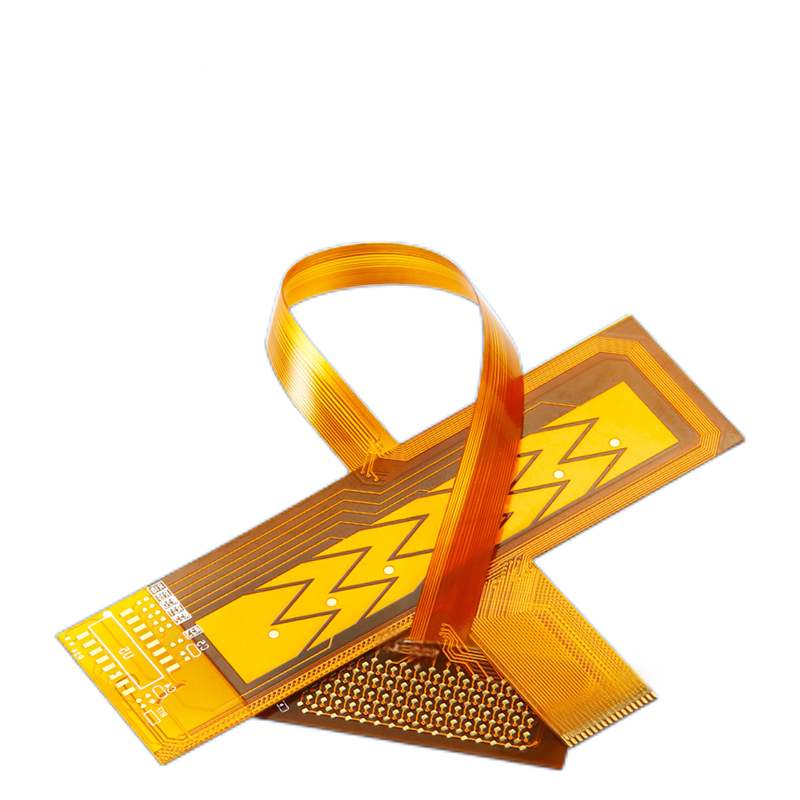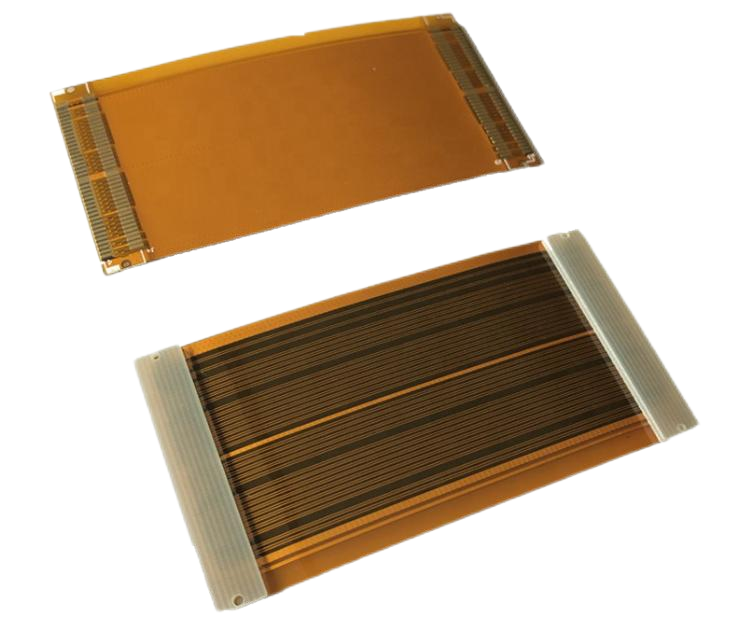Search
The Latest Trends in FPC Design and Production for the Display Industry
- Feb 19,2025
-
Share
In the dynamic landscape of the display industry, the design and production of Flexible Printed Circuits (FPCs) are currently undergoing a remarkable transformation, driven by several cutting - edge trends that are shaping the future of display technology.

Design Trends
Miniaturization and High - Density Interconnection (HDI)
1.Ultra - Fine Circuitry: The demand for ever - smaller and more complex circuits has led to a significant reduction in circuit pitches. In modern FPC manufacturing, the subtractive process can now achieve single - sided circuits with conductor pitches as narrow as 30 µm or even less. For double - sided circuits, pitches of 50 µm or below are becoming more common. When it comes to pitches under 25 µm, the semi - additive process (SAP) is often the go - to method. SAP enables the creation of high - precision circuits by first depositing a thin seed layer and then electroplating the metal to form the desired circuit pattern, minimizing material waste and enhancing circuit accuracy.
2.Micro - vias: The via holes that connect different conductor layers in multi - layer FPCs are getting smaller. Mass production has already reached the stage where via hole diameters can be less than 100 µm, and in some advanced manufacturing facilities, diameters as small as 10 µm are achievable. These micro - vias play a crucial role in reducing the overall size of the FPC while maintaining efficient electrical connectivity between layers.
Flexibility and Foldability
1.Enhanced Flexibility Performance: As the display market moves towards more flexible and foldable devices, such as foldable smartphones and rollable displays, FPCs are required to have superior flexibility and an ultra - small bending radius. This ensures that the electrical connections within the FPC remain intact after repeated bending cycles. Specialized flexible materials and unique circuit designs are being developed to meet these stringent requirements. For instance, materials with high elongation at break and low modulus of elasticity are being incorporated into FPC structures.
2.Innovative Mechanical Structures: New mechanical designs are emerging to support the unique form factors of modern displays. For example, the patented FPC storage structure for display panels by Trilliant Semiconductor features a bending - based storage mechanism. This allows the FPC board to be neatly stored along multiple sides of the screen body, optimizing the use of limited space within the device.
Intelligent and Multifunctional Integration
3.Function Convergence: FPCs are no longer just simple conductors but are evolving into intelligent components. They are increasingly being integrated with various sensors, such as touch sensors, ambient light sensors, and proximity sensors, as well as wireless communication modules like Bluetooth and Wi - Fi chips. This integration enables smart displays to perform a wide range of functions, from touch - based user interactions to real - time environmental monitoring and seamless wireless data transfer.
Production Trends
Advanced Materials
1.High - Performance Substrates: While polyimide (PI) has long been the standard substrate material for FPCs due to its excellent heat resistance, chemical stability, and mechanical strength, new materials are emerging. Polyethylene terephthalate (PET) is being used in some applications where cost - effectiveness and relatively lower performance requirements are acceptable. Additionally, research is focused on developing novel polyimide resins with enhanced properties, such as higher glass transition temperatures (Tg), lower coefficient of thermal expansion (CTE), and reduced moisture absorption. These improved properties are essential for high - density circuit designs and reliable operation in extreme environments.
2.Specialty Auxiliary Materials: The development of advanced adhesives, solder masks, and other auxiliary materials is crucial for the overall performance of FPCs. New adhesives are designed to provide stronger adhesion between different layers of the FPC, even under harsh mechanical and environmental conditions. Solder masks with better solderability and insulation properties are also being developed to ensure reliable soldering and prevent short - circuits.
Novel Manufacturing Processes
Laser Ablation Technology: Laser ablation has become an integral part of FPC production. This technology uses high - energy laser beams to precisely remove unwanted material, enabling the creation of smaller line widths and spacings. Laser ablation offers high processing accuracy, minimal heat - affected zones, and high production efficiency, making it an ideal choice for high - density circuit manufacturing.
Semi - Additive Process (SAP) Optimization: As mentioned earlier, the semi - additive process is gaining popularity for its ability to manufacture ultra - fine circuits. Recent advancements in SAP focus on improving the electroplating process, reducing the thickness of the seed layer, and enhancing the overall process control. This results in higher - quality circuits with better yield rates and improved electrical performance.
Sustainable Manufacturing
Use of Recyclable Materials: With growing environmental concerns and stricter regulations, FPC manufacturers are increasingly turning to recyclable materials. This includes using recycled plastics for substrates and developing recycling - friendly adhesives and coatings. By incorporating recyclable materials, the amount of electronic waste generated during the FPC's life cycle can be significantly reduced.
Energy - Efficient Production: Manufacturers are optimizing their production processes to minimize energy consumption. This involves using energy - efficient equipment, improving process control to reduce waste and rework, and implementing renewable energy sources in manufacturing facilities. These efforts not only contribute to environmental protection but also help reduce production costs in the long run.

Strategies Adopted by Leading FPC Manufacturers
Shenzhen Huaruixin Electronics Co., Ltd.
1.Optimizing Circuit Design: When developing FPCs for high - end tablet displays, Shenzhen Huaruixin Electronics Co., Ltd. utilized advanced electromagnetic field simulation software. By accurately simulating the electromagnetic environment within the FPC, they were able to re - route some signal lines. This not only reduced cross - talk between adjacent lines by 30% but also decreased power consumption by 15%, ensuring stable and efficient signal transmission in a compact design.
2.Improving Production Processes: The company invested in a high - precision laser - direct - imaging (LDI) system. In the production of FPCs for smartwatch displays, this LDI system could achieve a line width accuracy of ±5 µm, far exceeding the previous mechanical imaging accuracy. As a result, the production yield of high - density FPCs for smartwatches increased from 80% to 90%, and the production cycle was shortened by 20%.
3.Strengthening Quality Detection: Shenzhen Huaruixin Electronics Co., Ltd. introduced an AI - powered AOI system. During the production of FPCs for automotive displays, this system could detect even the tiniest defects, such as a 20 - µm short - circuit trace. It also had the ability to analyze defect patterns in real - time, providing valuable data for process improvement. As a result, the number of defective products reaching the end - user decreased by 80%.

The strategies implemented by companies Shenzhen Huaruixin Electronics Co., Ltd. provide valuable insights for other FPC production enterprises. By leveraging these strategies, these enterprises can enhance their product quality, adapt to the ever - changing demands of the display industry, and gain a significant competitive edge in the market.

Let’s talk! We’ll provide the perfect solution for you!
-
 Huaruixin Electronics mainly produces printed circuit boards as the core business, to provide customers with one-stop solutions for FPC/PCB production, components sourcing and Assembly.
Huaruixin Electronics mainly produces printed circuit boards as the core business, to provide customers with one-stop solutions for FPC/PCB production, components sourcing and Assembly. - WHAT WE DO — PCB Design Solutions — Flex PCB Production — Components Sourcing — FPC&PCB Assembly
- PRODUCTS — Single Sided Flexible Circuits — Double Sided Flexible Circuits — Multilayer Flexible Cirucits — Rigid-Flex Circuits — FPC Assembly — PCB Assembly
- CAPABILITY — FPC Capability — Rigid-Flex Capability — PCB Capability — Assembly Capability
- Copyright © 2024 Shenzhen Huaruixin Electronics Co., Ltd. All Rights Reserved.
- Design By BONTOP


